25th Dynasty (Nubians)
Q737648Nubian or Kushite Pharaohs: other, common name of the pharaohs of the Twenty-fifth dynasty, which originally ruled the Nubian kingdom of Napata. They ruled over Egypt from the late eighth century to 666 BCE.
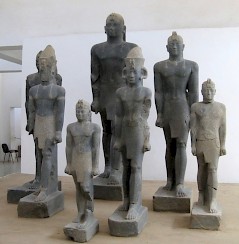
Nubia, Kush, and Napata, are the names of a group of towns near the fourth cataract of the Nile, of which Gebel Barkal, El-Kurru, Sanam, and Nuri are the most important. The area produced gold and was conquered by the Egyptian pharaohs of the Eighteenth Dynasty (1540-1295), and became Egyptianized. During the Twentieth Dynasty (1188-1069), it became independent, although it still traded with Egypt; the most important product in this age was ivory, which also reached Assyria. The elite that monopolized this trade was probably also able to seize power and become king.
Piye
Meanwhile, princes and kings from Libya took over power in Egypt. Divided as the country was, it was an easy prey for the Nubian king Piye. The occupation may have been appreciated by the native Egyptian population, because the Nubian kings offered stability and did much to restore the ancient shrines. Generally speaking, the arts in this period were inspired by past masters; depending on one's artistic taste, one may call it a brilliant Renaissance or a soulless imitation.
The main source for the conquest is the Victory Stela that was found in the temple of Amun at Gebel Barkal. It tells how Piye subdued the two rulers of Upper Egypt, proceeded to Memphis, captured this city, and received tokens of submission from the princes of Lower Egypt, including his main adversary, Tefnakht of Sais (Twenty-fourth Dynasty). The event cannot be dated precisely; nor can it have been Nubia's first involvement in Egyptian affairs, as Piye's relative (sister?) Amenirdis had already been appointed as successor of the God's Wife of Amun in Thebes, a very important office.
Shabaqo
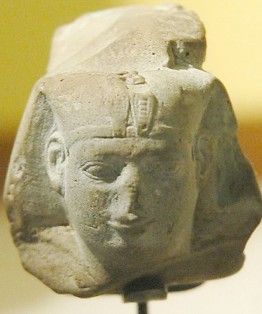
Piye was succeeded by Shabaqo, who may have been his brother, in 716 (the date is contested). Unlike his predecessor, he was often in Egypt, probably residing in Thebes, where he revived the office of high priest, which he awarded to his son Horemakhet. Control was exercised over Lower Egypt, but it was not too tight and the local princes maintained contacts with the cities of Palestine and the Levant.
Shebitqo
His successor, Shebitqo, inherited this involvement in the northeast, and was involved in a major war against the Assyrian king Sennacherib in 701. The Egyptian armies were defeated, but prevented Sennacherib from seizing all of Palestine; the small kingdom of Judah maintained its independence, and Assyria could not conquer the entire region.
Taharqo
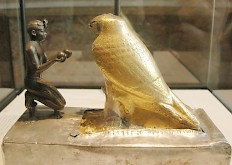
Taharqo is the best known of all Nubian rulers. He was crowned king in c.690 in Memphis and devoted himself to all kinds of peaceful works, like the restoration of ancient temples in both Egypt and Nubia and building new sanctuaries, like the one at Kawa. In February/March 673, an army sent by the Assyrian king Esarhaddon was defeated by the Egyptians, but this was the last of Egyptian successes. In April 671, the Assyrians were back, and this time, they captured Memphis (11 July). Taharqo had left the city, but his brother and son were taken prisoner.
In Lower Egypt, Esarhaddon appointed the native princes as governors. One of these was Necho I, a descendant of Tefnakht, who resided in Sais in the western Delta. Meanwhile, Taharqo fought back, reoccupied in Memphis in 669, and forced the princes into submission.
| Alara | c.780-c.760 |
| Maatra Kashta | c.760-c.747 |
| Usermara Sneferra Piye | c.747-c.716 |
| Neferkara Shabaqo | c.716-c.702 |
| Djedkaura Shebitqo | c.702-c.690 |
| Nefertumkhura Taharqo | c.690-664 |
| Bakara Tanwetamani | 664-after 656 |
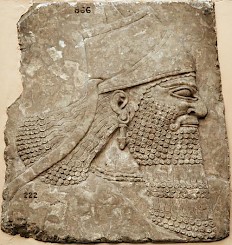
This provoked a third Assyrian campaign, which was broken off because Esarhaddon died. He was succeeded by Aššurbanipal, who conducted the fourth campaign in 667/666, took Memphis, and sacked Thebes. Because the princes were obviously unreliable, the Assyrian king chose one of them who could be trusted: Necho. When, after Taharqo's death in 664, his successor Tanwetamani tried to reconquer Memphis (the subject of the Dream Stela), Necho beat him, and although he was killed in action, power remained in his family. It was his son Psammetichus I, who unified Egypt, and was clever enough to give the Assyrians the impression that he still served them once they had been forced to recall their garrisons when civil war broke out in Assyria (651-648).
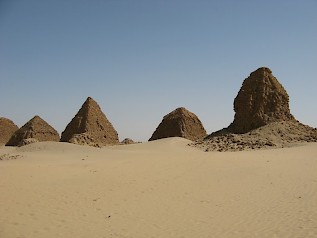
Taharqo was the first Nubian king to be buried in a pyramid near Nuri. This cemetery would be used for more than three centuries, although the capital was transferred to Meroe.
Literature
- T.G.H. James, "Egypt. The Twenty-Fifth and Twenty-Sixth Dynasties" in: Cambridge Ancient History (second edition, 1991), vol.III, part two, pp.677-747
- Robert G. Morkot, The Black Pharaohs. Egypt's Nubian Rulers (2000 London)
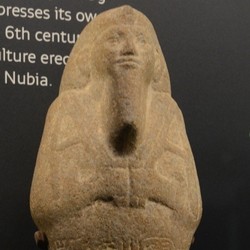 Nuri, Shabti of Taharqo |
 Sanam, Temple of Taharqo, Four baboons |
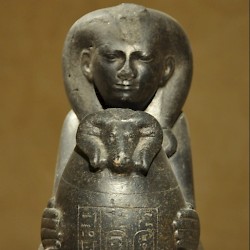 Karnak, Sphinx of Shepenupet II (god's wife of Amun) |
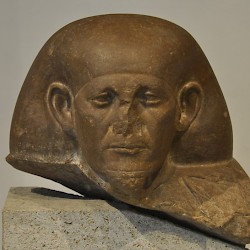 Head of a block statue |